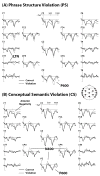Syntax, concepts, and logic in the temporal dynamics of language comprehension: evidence from event-related potentials
- PMID: 20138065
- PMCID: PMC2862874
- DOI: 10.1016/j.neuropsychologia.2010.01.013
Syntax, concepts, and logic in the temporal dynamics of language comprehension: evidence from event-related potentials
Abstract
Logic has been intertwined with the study of language and meaning since antiquity, and such connections persist in present day research in linguistic theory (formal semantics) and cognitive psychology (e.g., studies of human reasoning). However, few studies in cognitive neuroscience have addressed logical dimensions of sentence-level language processing, and none have directly compared these aspects of processing with syntax and lexical/conceptual-semantics. We used ERPs to examine a violation paradigm involving "Negative Polarity Items" or NPIs (e.g., ever/any), which are sensitive to logical/truth-conditional properties of the environments in which they occur (e.g., presence/absence of negation in: John hasn't ever been to Paris, versus: John has *ever been to Paris). Previous studies examining similar types of contrasts found a mix of effects on familiar ERP components (e.g., LAN, N400, P600). We argue that their experimental designs and/or analyses were incapable of separating which effects are connected to NPI-licensing violations proper. Our design enabled statistical analyses teasing apart genuine violation effects from independent effects tied solely to lexical/contextual factors. Here unlicensed NPIs elicited a late P600 followed in onset by a late left anterior negativity (or "L-LAN"), an ERP profile which has also appeared elsewhere in studies targeting logical semantics. Crucially, qualitatively distinct ERP-profiles emerged for syntactic and conceptual semantic violations which we also tested here. We discuss how these findings may be linked to previous findings in the ERP literature. Apart from methodological recommendations, we suggest that the study of logical semantics may aid advancing our understanding of the underlying neurocognitive etiology of ERP components.
2010 Elsevier Ltd. All rights reserved.
Figures







Similar articles
-
Interplay between syntax and semantics during sentence comprehension: ERP effects of combining syntactic and semantic violations.J Cogn Neurosci. 2003 Aug 15;15(6):883-99. doi: 10.1162/089892903322370807. J Cogn Neurosci. 2003. PMID: 14511541
-
Event-related potentials suggest early interaction between syntax and semantics during on-line sentence comprehension.Neurosci Lett. 2005 Aug 26;384(3):222-7. doi: 10.1016/j.neulet.2005.04.076. Neurosci Lett. 2005. PMID: 15894426 Clinical Trial.
-
Verbing nouns and nouning verbs: Using a balanced design provides ERP evidence against "syntax-first" approaches to sentence processing.PLoS One. 2020 Mar 13;15(3):e0229169. doi: 10.1371/journal.pone.0229169. eCollection 2020. PLoS One. 2020. PMID: 32168357 Free PMC article.
-
Neural mechanisms of language comprehension: challenges to syntax.Brain Res. 2007 May 18;1146:23-49. doi: 10.1016/j.brainres.2006.12.063. Epub 2006 Dec 23. Brain Res. 2007. PMID: 17400197 Review.
-
The fractionation of spoken language understanding by measuring electrical and magnetic brain signals.Philos Trans R Soc Lond B Biol Sci. 2008 Mar 12;363(1493):1055-69. doi: 10.1098/rstb.2007.2159. Philos Trans R Soc Lond B Biol Sci. 2008. PMID: 17890190 Free PMC article. Review.
Cited by
-
Backward Dependencies and in-Situ wh-Questions as Test Cases on How to Approach Experimental Linguistics Research That Pursues Theoretical Linguistics Questions.Front Psychol. 2018 Jan 11;8:2237. doi: 10.3389/fpsyg.2017.02237. eCollection 2017. Front Psychol. 2018. PMID: 29375417 Free PMC article. Review.
-
Assessing the Role of Experimental Evidence for Interface Judgment: Licensing of Negative Polarity Items, Scalar Readings, and Focus.Front Psychol. 2018 Feb 21;9:59. doi: 10.3389/fpsyg.2018.00059. eCollection 2018. Front Psychol. 2018. PMID: 29515470 Free PMC article. Review.
-
Endogenous Oscillations Time-Constrain Linguistic Segmentation: Cycling the Garden Path.Cereb Cortex. 2021 Jul 29;31(9):4289-4299. doi: 10.1093/cercor/bhab086. Cereb Cortex. 2021. PMID: 33949654 Free PMC article.
-
Bilingual Processing Mechanisms of Scientific Metaphors and Conventional Metaphors: Evidence via a Contrastive Event-Related Potentials Study.Front Psychol. 2022 Jun 20;13:894114. doi: 10.3389/fpsyg.2022.894114. eCollection 2022. Front Psychol. 2022. PMID: 35795431 Free PMC article.
-
Novel ERP Evidence for Processing Differences Between Negative and Positive Polarity Items in German.Front Psychol. 2019 Mar 6;10:376. doi: 10.3389/fpsyg.2019.00376. eCollection 2019. Front Psychol. 2019. PMID: 30894822 Free PMC article.
References
-
- Barwise J, Cooper R. Generalized quantifiers and natural language. Linguistics and Philosophy. 1981;4:159–219.
-
- beim Graben P, Drenhaus H, Brehm E, Rhode B, Saddy D, Frisch S. Enhancing dominant modes in nonstationary time seris by means of the symbolic resonance analysis. Chaos. 2007;17:043106. - PubMed
-
- Bentin S, McCarthy G, Wood CC. Event-related potentials, lexical decision and semantic priming. Electroencephalography and Clinical Neurophysiology. 1985;60:343–55. - PubMed
-
- Bornkessel I, Schlesewsky M. The extended argument dependency model: A neurocognitive approach to sentence comprehension across languages. Psychological Review. 2006;113(4):787–821. - PubMed
-
- Borkessel-Schlesewsky I, Schlesewsky M. An alternative perspective on “semantic P600” effects in language comprehension. Brain Research Reviews. 2008;59:55–73. - PubMed
Publication types
MeSH terms
Grants and funding
LinkOut - more resources
Full Text Sources

